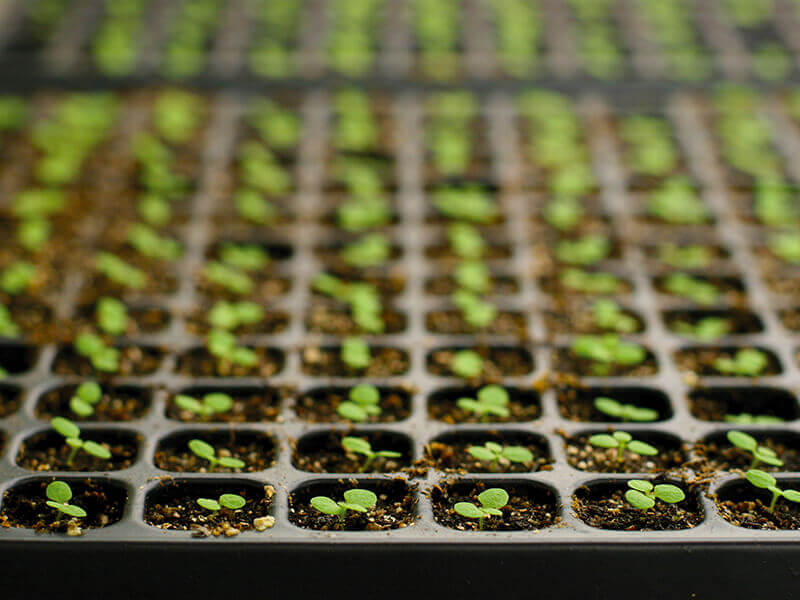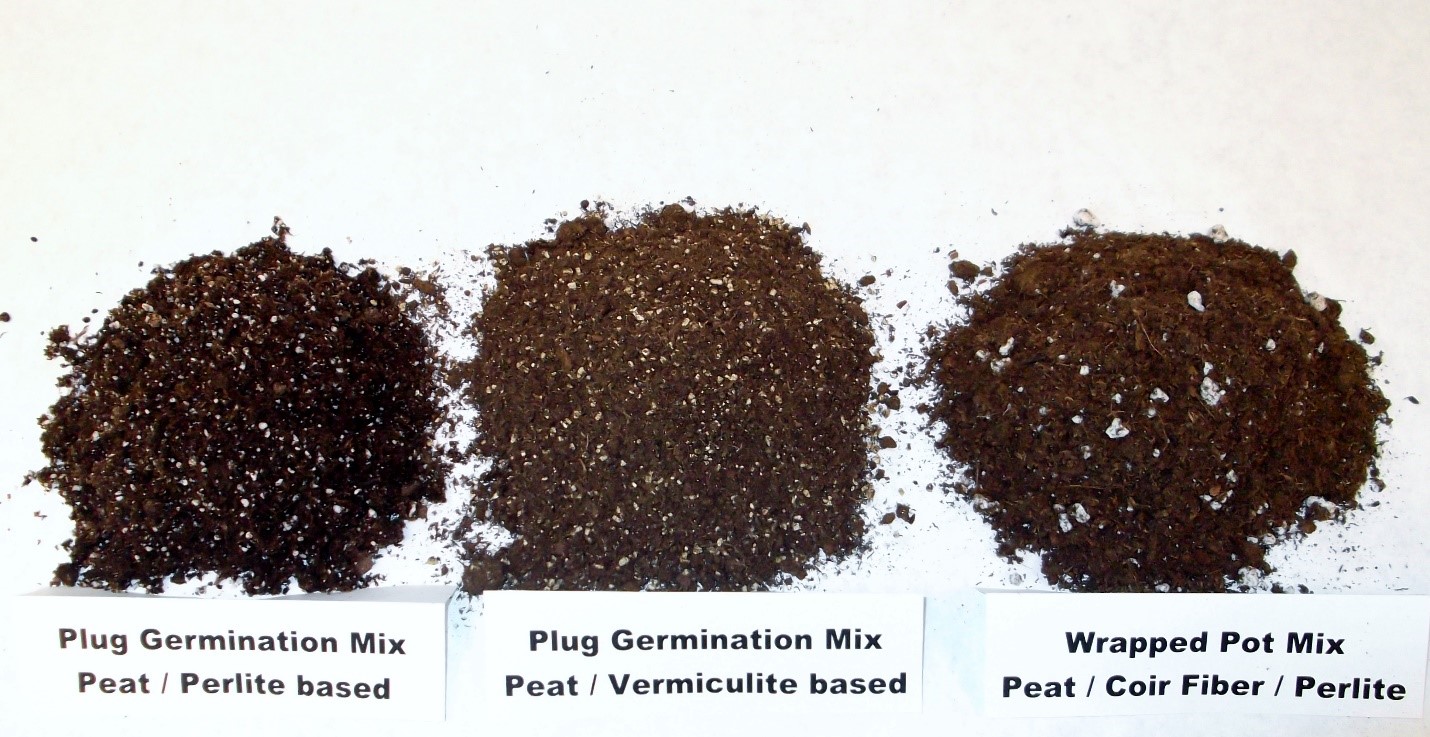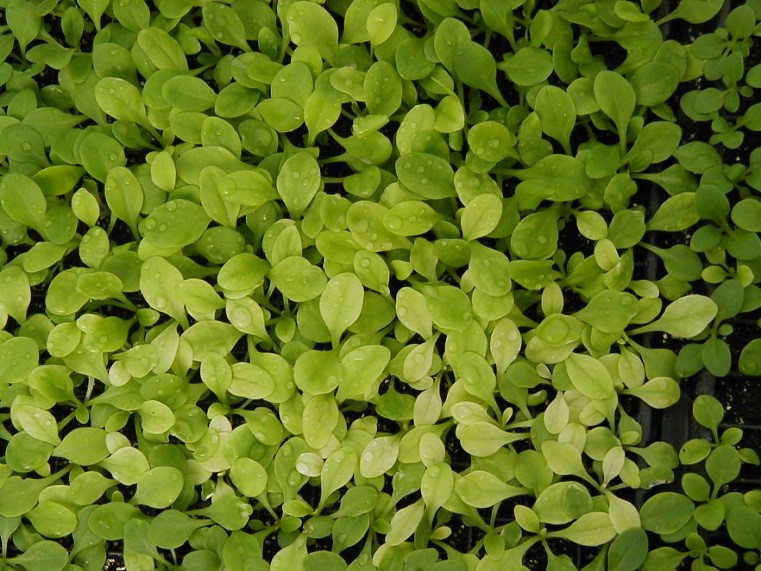what nutrients and how much to give seedlings
Back
Nutrition Tips for Seed Germination and Young Plants
Monday, February 14, 2022 | Ed Bloodnick
PDF version of this text: Diet Tips for Seed Formation and Young Plants

"Young plants propagation. Photo Credit: istockphoto.com"
Seed germination and young plant production starts with the right growing medium or substrate. Information technology is of import to have a substrate with good physical characteristics, such equally air porosity and water holding capacity, however chemical characteristics are equally important. Correct starting pH, electric conductivity and food content are necessary for favorable immature plant development. In one case seeds are sown or cuttings stuck, the grower must monitor pH and nutrient status. Here are some tips to make the proper cultural adjustments during the crop cycle to attain success.
Go along in mind that germinating seeds and rooting cuttings in plug trays is high density product, meaning that the developing root organization is limited to a very modest amount of growing medium. Therefore, nutrient condition and pH can change very easily from irrigation and fertilizer applications. Knowing this, the benefit is that you can make cultural adjustments quickly and easily. However, it is also easy to go far trouble, and then attending to detail is very important for minor cell culture. Larger jail cell plug trays and taller trays are more forgiving, since they hold more substrate and therefore, crave less frequent application of irrigation water/fertilizer solution.

Examples of different growing media used for diverse young plant production methods. Each is specialized and growers should evaluate products to decide which growing medium is all-time for their growing needs.
Fertilization Requirements of Seedlings
Seedlings do non need fertilizer from sowing through the get-go week later on germination because the cotyledons, which are preformed inside the seed, have all the initial nutrition needed to sustain seedling growth. A week after germination, seedlings require a small corporeality of nutrients, mainly N, P and K.
Remember, seedlings and plants will not grow faster or meliorate by applying higher than recommended rates of fertilizer; in fact, over-fertilizing can consequence in a negative impact on growth (plants become stretched or distorted), algae formation on the growing medium surface which attracts shore flies and fungus gnats and build up of fertilizer salts which can fire roots and kill seedlings. Young seedlings are particularly sensitive to high fertilizer/salt levels in the substrate, so the Electrical Conductivity (EC) should be monitored and maintained below 1.5 dS/m (mmhos/cm) using the 2:one growing medium test method.
Seed germination substrates, like PRO-MIX® FPX, contain a balmy, starter fertilizer charge to fulfill initial nutrient requirements of seedlings up to the germination of the first set of true leaves.
Fertility Programme
Keep in mind that there is no perfect fertilizer or nutrient solution for all plants. Plant nutrient needs depend on the plant species, stage of plant development, season of the twelvemonth and environmental conditions. Water quality must too exist considered, since dissolved minerals and water alkalinity have an impact on fertilizer selection. Many fertilizer companies offer calcium-magnesium (cal-mag) formulations for seedlings and young plants that work well, since these formulations provide higher amounts calcium, magnesium and micronutrients than standard fertilizer formulations when feeding at depression nitrogen rates.

Example of iron deficiency in petunia plugs from high pH of growing medium caused by high water alkalinity and improper fertilizer selection
Depending on your water quality, it may exist best to alternate with a potentially acid fertilizer, since many of the cal-mag fertilizers tend to raise growing media pH. Employ fertilizer every bit a constant feed, with every quaternary irrigation with articulate water. Fertilizer application rates can start with fifty ppm North, and so increment to 100 ppm N just prior to transplant. After transplant, Northward tin can be maintained at 100 ppm or increased to 150-200 ppm N depending on the found species. Accommodate application rate based on plant response and the amount of sunlight.
Benefits of Active ingredients
PRO-MIX®FPX is available every bit standard blends or with BIO-FUNGICIDETM for added protection for your plants from root pathogens. BIOF-UNGICIDETM is beneficial Bacillus bacterium that is registered with the EPA for suppression of damping off and the root rot pathogens Fusarium, Pythium and Rhizoctonia. Information technology works by reducing root disease symptoms by one or a combination of mechanisms to provide a competitive advantage over the pathogen. BIO-FUNGICIDETMdoes this past a combination of directly destruction of pathogen, a reduction of the spread of the pathogen and/or pathogen exclusion from the site of infection at the institute root. When the plant's root organization comes into contact with Bacillus, the bacterial spores germinate and brainstorm to colonize the establish's roots within 48 hours. The leaner grow effectually the root system to form a protective shield that serves as a physical bulwark to certain root rot pathogens. Illness suppression occurs with all crops including vegetables, ornamental greenhouse plants, perennial and plant nursery crops. PRO-MIX® BIO-FUNGICIDETM products protect your plants and reduce incidence of root diseases.
*PRO-MIX® BIO-FUNGICIDETM growing media products are merely bachelor in the Us.
For more information, contact your Premier Tech Grower Services Representative:
 |  |  |
|---|---|---|
| Ed Bloodnick | JoAnn Peery | Lance Lawson |
 |  |  |
| Troy Buechel | Susan Parent | Jose Chen Lopez |
PRO-MIX® is a registered trademark of PREMIER HORTICULTURE Ltd.
jacksontreadevent77.blogspot.com
Source: https://www.pthorticulture.com/en/training-center/nutrition-tips-for-seed-germination-and-young-plants/
0 Response to "what nutrients and how much to give seedlings"
Post a Comment